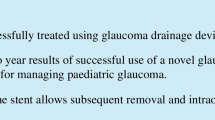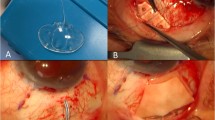Abstract
Background
The two glaucoma drainage devices (GDD) Ahmed and Baerveldt tubes are most commonly used for the treatment of refractory glaucoma. We noticed a significant number of patients with postoperative motility disorders resulting in diplopia. We investigated the occurrence and patterns of postoperative motility disorders overall and between the two GDD tubes using the Hess Screen Test.
Methods
Retrospective single-center matched case series of 20 patients undergoing Ahmed and 20 patients undergoing Baerveldt tube implantation with a follow-up of at least 1 year. In order to investigate the dynamic of GDD-induced motility disorder over time, from 25 patients, a follow-up examination from two different time periods (3 to 6 months and 12 to 24 months postoperatively) was available. From these 25 patients, 12 had received an Ahmed and 13 a Baerveldt GDD. To compare the different Hess Screen Tests, we developed nine categories of possible emerging motility disorder in the operated eye as a primary endpoint: Motility restriction in up-gaze, in down-gaze, in abduction, in adduction; combined motility disorders in up-gaze and adduction, up-gaze and abduction, down-gaze and adduction, down-gaze and abduction. If there was no motility disorder, this was also separately classified.
Results
Regardless of the used device, Ahmed or Baerveldt, most patients experienced motility disorders to some extent; mainly down-gaze and adduction were affected. However not every motility disorder resulted in diplopia. Although over time a decrease in ocular misalignment was seen, the incidence of diplopia was stable. Nevertheless, only few required therapy. We noted no difference between Ahmed and Baerveldt tube implant devices.
Conclusion
Ocular misalignment and restriction of motility is a common finding after GDD. Although not every motility disorder results in diplopia, it is frequent. Therefore, it needs to be taken into consideration in informed consent.





Similar content being viewed by others
References
Nguyen QH (2004) Avoiding and managing complications of glaucoma drainage implants. Curr Opin Ophthalmol 15(2):147–150
Sun PY, Leske DA, Holmes JM, Khanna CL (2017) Diplopia in medically and surgically treated patients with glaucoma. Ophthalmology 124(2):257–262
Budenz DL, Feuer WJ, Barton K, Schiffman J, Costa VP, Godfrey DG et al (2016) Postoperative complications in the Ahmed Baerveldt comparison study during five years of follow-up. Am J Ophthalmol 163:75-82.e3
Gedde SJ, Feuer WJ, Lim KS, Barton K, Goyal S, Ahmed IIK, Brandt JD (2020) Treatment outcomes in the primary tube versus trabeculectomy study after 3 years of follow up. Ophthalmology 127:333–345
Robbins L, Goseki T, Law SK, Nouri-Mahdavi K, Caprioli J, Coleman AL, Giaconi JA, Demer JL, Velez FG, Pineles SL (2021) Strabismus after Ahmed glaucoma valve implantation. Am J Ophthalmolo 222:1–5
Abdelaziz A, Capo H, Banitt MR, Schiffman J, Feurer WJ, McKeown CA, Spencer NE, Parrish RK (2013) Diplopia after glaucoma drainage device implantation. J AAPOS 17:192–196
Kilgore KP, Wang F, Stern NC, Dogahe SJ, White LJ, Khanna CL (2020) Health-related quality of life in Ahmed FP7, and Baerveldt 250 and 350 patients compared with medical controls. Br J Ophthalmol. https://doi.org/10.1136/bjophthalmol-2020-317856
Khanna CL, Leske DA, Holmes JM (2018) Factors associated with health-related quality of life in medically and surgically treated patients with glaucoma. JAMA Ophthalmol 136(4):348–355
Vinod K, Gedde SJ, Feuer WJ, Panarelli JF, Chang TC, Chen PP et al (2017) Practice preferences for glaucoma surgery: a survey of the American Glaucoma Society. J Glaucoma 26(8):687–693
Lloyd MA, Baerveldt G, Fellenbaum PS, Sidoti PA, Minckler DS, Martone JF et al (1994) Intermediate-term results of a randomized clinical trial of the 350- versus the 500-mm2 Baerveldt implant. Ophthalmology 101(8):1456–1463
Roy S, Ravinet E, Mermoud A (2001) Baerveldt implant in refractory glaucoma: long-term results and factors influencing outcome. Int Ophthalmol 24(2):93–100
Hong CH, Arosemena A, Zurakowski D, Ayyala RS (2005) Glaucoma drainage devices: a systematic literature review and current controversies. Surv Ophthalmol 50(1):48–60
Rauscher FM, Gedde SJ, Schiffman JC, Feuer WJ, Barton K, Lee RK et al (2009) Motility disturbances in the tube versus trabeculectomy study during the first year of follow-up. Am J Ophthalmol 147(3):458–466
Krishna R, Godfrey DG, Budenz DL, Escalona-Camaaño E, Gedde SJ, Greenfield DS et al (2001) Intermediate-term outcomes of 350-mm(2) Baerveldt glaucoma implants. Ophthalmology 108(3):621–626
Smith SL, Starita RJ, Fellman RL, Lynn JR (1993) Early clinical experience with the Baerveldt 350-mm2 glaucoma implant and associated extraocular muscle imbalance. Ophthalmology 100(6):914–918
Zee DS, Chu FC, Optician LM, Carl JR, Reingold D (1984) Graphical analysis of paralytic strabism with the Lancaster red-green test. Am J Ophthalmol 97:587–590
Author information
Authors and Affiliations
Corresponding author
Ethics declarations
Ethical approval
All procedures performed in studies involving human participants were in accordance with the ethical standards of the local ethics committee (Ethikkommission Nordwest- und Zentralschweiz—EKNZ) and with the 1964 Helsinki declaration and its later amendments or comparable ethical standards.
Informed consent
Informed consent was obtained from all individual participants included in the study.
Conflict of interest
The authors declare no conflict of interest.
Additional information
Publisher’s note
Springer Nature remains neutral with regard to jurisdictional claims in published maps and institutional affiliations.
Rights and permissions
About this article
Cite this article
Scherrer, E., Bachmann, L.M., Job, O. et al. Occurrence of motility disorders in patients undergoing tube surgery—consecutive, retrospective follow-up case series analysis. Graefes Arch Clin Exp Ophthalmol 259, 2363–2371 (2021). https://doi.org/10.1007/s00417-021-05202-3
Received:
Revised:
Accepted:
Published:
Issue Date:
DOI: https://doi.org/10.1007/s00417-021-05202-3




